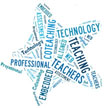While authoring my forthcoming book, Maximizing School Librarian Leadership: Building Connections for Learning and Advocacy, I have read many professional books. This is the seventh in a series of professional book reviews–possible titles for your summer reading. The reviews are in no particular order.
 On June 12, 2017, I attended an ASCD Webinar presented by authors Eric C. Sheninger and Thomas C. Murray. (If you missed it, I highly recommend the webinar archive.) Their presentation was centered on their hot-off-the-presses book Learning Transformed: 8 Keys to Designing Tomorrow’s Schools, Today. After the webinar, I preordered a copy of their book and read it as I was completing my own manuscript.
On June 12, 2017, I attended an ASCD Webinar presented by authors Eric C. Sheninger and Thomas C. Murray. (If you missed it, I highly recommend the webinar archive.) Their presentation was centered on their hot-off-the-presses book Learning Transformed: 8 Keys to Designing Tomorrow’s Schools, Today. After the webinar, I preordered a copy of their book and read it as I was completing my own manuscript.
This book focuses on creating a culture of innovation and leading change. In reviewing their table of contents, I found so many parallels between their book and mine that I was, at first, reluctant to read it… until after I had submitted my manuscript. However, my curiosity won out. And I am glad it did. Reading their work at the 11th hour in my process gave me an opportunity to further develop my thinking, reflect, and include some quotes from their book in mine.
In Learning Transformed, Sheninger and Murray identify “eight keys for intentional design.” They are:
1. Leadership and school culture lay the foundation.
2. The learning experience must be redesigned and made personal.
3. Decisions must be grounded in evidence and driven by Return on Instruction.
4. Learning spaces must become learner-centered.
5. Professional learning must be relevant, engaging, ongoing, and made personal.
6. Technology must be leveraged and used as an accelerant for student learning.
7. Community collaboration and engagement must be woven into the fabric of a school’s culture.
8. Schools that transform learning are built to last as financial, political, and pedagogical sustainability ensure long-term success (24-27).
I could not agree more about the importance of leadership and culture in creating the context for educational transformation. I believe future-ready librarians are positioned to be leaders and culture-builders in their schools.
For those of us in the school library profession, “inquiry” is the process that we promote for redesigning learner-centered/personalized learning. Sheninger and Murray offer thoughtful strategies for leaders to make student agency a reality in their schools. Among them are standards-aligned learning activities and assessments, student mastery of selecting the right tool for the task, portfolios as authentic assessments, student involvement in rule making, and participation in feedback loops—choice and voice (76-77).
Decision-making based on evidence also resonates with school librarians who develop library programs using evidence-based practice. One term that Sheninger and Murray use with which I was previously unfamiliar was Return on Instruction (ROI). They used this term in relationship to the funds and time spent on the latest technology tools and devices and ROI, evidence of improved student learning outcomes.
I found the parallel between ROI and Return on Investment an important one. School librarians who serve as technology stewards evaluate and field-test digital resources and tools based on sound pedagogical practices and learning goals can be leaders in their schools in ensuring a positive ROI. School librarians also provide formal professional development and job-embedded personalized learning for colleagues through coplanning and coteaching.
School librarians who have developed a learning commons model in their school libraries may be particularly interested in the chapter entitled “Designing Learner-Centered Spaces.” I suspect they will echo the authors’ contention that flexible spaces that “provide areas for movement, and promote collaboration and inquiry” (25) are needed if students are to explore creativity and reach for innovation.
As a reader, I found the format friendly, quotes thoughtful, and examples from the field compelling. I suspect many readers will compare their teaching and learning environments to those described in the book. It would be important to find as many similar assets with these sites and explore how your own school could further expand its areas of strength.
As an author, I was impressed by the endorsements Sheninger and Murray received for this book. Sir Ken Robinson, Linda Darling-Hammond, Daniel H. Pink, Robert Marzano, Michael Fullan, and many more education thought leaders have high praise for Learning Transformed.
If you are in a formal or informal leadership position in your school or district (e.g. future-ready librarians and school library supervisors), then you will want to read this book and discuss it with the decision-makers in your school and district.
Work Cited
Sheninger, Eric C., and Thomas C. Murray. Learning Transformed: 8 Keys to Designing Tomorrow’s Schools, Today. Alexandria, VA: Association for Supervision and Curriculum Development, 2017.






